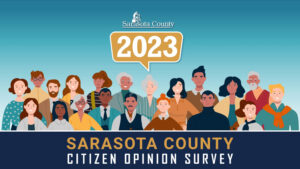The pandemic is over, the job market is booming. What gives?
By Sarah Malickson
Original Air Date: Oct. 13, 2023
Host: The annual Citizens’ Survey commissioned by Sarasota County reflects high levels of satisfaction with the services the county provides and considerable trust in local government. But the responses also show some of the anxieties of county residents. In the latest survey, for instance, a quarter of the 1,250 respondents said that overdevelopment is at the top of their concerns. But the most worrying trend was revealed by a question towards the end of the survey: “What would you say is putting the greatest stress on your own household’s finances right now?” WSLR reporter Sarah Malickson has more on that.
Ashley Brown: From the increase in housing prices, to the issue with insurance, to inflation – it just creates barriers and obstacles for people being able to afford to live.
Sarah Malickson: That is Ashley Brown, CEO of the Women’s Resource Center.
A couple of weeks ago, Sarasota County released their 2023 citizens’ survey. The University of South Florida and HCP Associates conduct this annual survey, and this year their findings have raised concern about rising financial stress among Sarasota households. That stress has multiplied over the the last years, affecting four out of five households. This year, less than a quarter – only 21% – of residents reported no financial stress. That’s compared to 42% living in bliss in 2019 and 43% in 2020. In 2021, there was a steep drop that coincided with the pandemic, when only 28% said they felt no financial stress. That was followed by another drop to 23% last year. And now, things are still getting worse for most people here: In this survey, there was another 2% drop, to 21%.
The 79% who did say they were under financial duress cited – in that sequence – household finances in general, gas prices, taxes in general, personal debt, property taxes, healthcare costs, home insurance, and prescription costs.
 So, what do these numbers mean for county social service organizations and their clients? Ashley Brown of the Women’s Resource Center shared that there are plenty of contributors to financial stress amongst her clients, the most notable being the financial burdens cited in the survey. She points out that elderly women are the group that seems hardest hit.
So, what do these numbers mean for county social service organizations and their clients? Ashley Brown of the Women’s Resource Center shared that there are plenty of contributors to financial stress amongst her clients, the most notable being the financial burdens cited in the survey. She points out that elderly women are the group that seems hardest hit.
AB: One of the saddest trends is the number of elder women that we’re seeing that are going back to work to make a little extra income, because either their fees have gone up, or just the cost of living has gone up, and they need to go to work again. This is 75 to 80 year-old women.
SM: Already as of 2018, slightly more than half of single elder women households lived without what is defined as economic security, whereas single elder male households were a bit better off. In contrast, less than one-fourth of coupled households had economic security challenges. Brown said that this is just one of the many issues brought to the attention of the Women’s Resource Center over the last few years.
AB: We have seen a huge increase in … the need for affordable housing since the pandemic. And then with inflation, we’ve seen more people struggling to make ends meet.
SM: Along with housing, obtaining childcare for working families and its costs is a main contributor to stress.
AB: So for the working families that have children at home, there’s a couple of points of that issue that are problematic: There’s not a lot of options, and there’s childcare centers that are closing because they don’t have the staff … And then, the cost of childcare is the second biggest expense in the budget for a family. It is really expensive, and you have to have it if you want to keep working, and you want your kids to be in a safe, healthy environment. 
SM: The regional chapter of United Way puts together the annual ALICE report. ALICE stands for “Asset Limited, Income Constrained. but Employed” – the acronym others refer to as “working poor”. According to the ALICE report, 45% of people in Florida fall into that category, making more than the federal poverty level, but not earning enough to afford the basics. In Sarasota County, according to the most recent ALICE report, 38% of people live below the sustainable wage level. I spoke to Ernest Hooper of United Way. He mentioned that financial stress worsened after the pandemic, when federal relief programs went away.
Ernest Hooper: There were federal relief programs that helped people in 2020 and 2021. But those programs went away at the end of 2021.
SM: Hooper emphasized that there is no sugar-coating this: Sarasota County residents and Floridians altogether are under immense financial stress.
EH: The struggle is real for many, many people in Sarasota County and across the state. You may see some indications that everyone is getting fat and happy in Florida, but it’s not the case at all.
SM: However, the Women’s Resource Center’s Brown says that despite these struggles, we have a strong community that is willing to work to alleviate some of this stress.
AB: We do have a community that’s rich in resources, and I think there’s a lot of people who are interested in working on the issues. So we’re fortunate in that regard.
This has been Sarah Malickson with WSLR News
WSLR News aims to keep the local community informed with our 1/2 hour local news show, quarterly newspaper and social media feeds. The local news broadcast airs on Wednesdays and Fridays at 6pm.